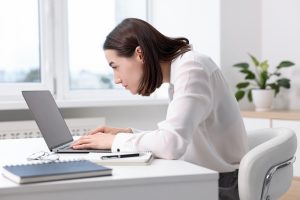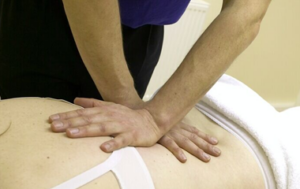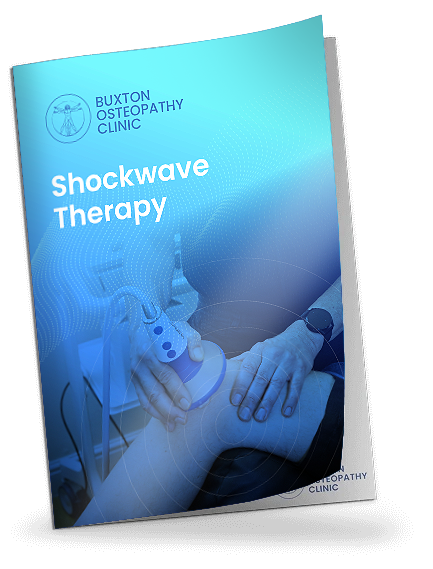Poor posture through slouching and carrying frequent heavy loads can cause supporting muscles and ligaments to stretch in the spine.Lower back pain, neck tension, and spinal discomfort are among the most common issues affecting people today — and one of the biggest reasons patients walk through our doors at Buxton & Bakewell Osteopathy Clinic. While many factors can contribute to spinal problems, posture is one of the most influential, and often one of the most overlooked. In an age where we spend more time sitting, scrolling, working at screens, and moving less than ever, the way we position our bodies has a profound impact on how our spine functions, how our muscles behave, and ultimately how we feel every single day.

Your spine is an incredible piece of engineering — strong enough to support your entire body and flexible enough to allow bending, twisting, lifting, and movement. But like any structure, it works best when aligned properly. Poor posture places abnormal strain on the vertebrae, intervertebral discs, facet joints, ligaments, and surrounding muscles. Over time, this strain can build into stiffness, muscle fatigue, nerve irritation, and chronic lower back pain. What starts as a slight slouch or subtle forward-head posture can eventually lead to persistent discomfort, reduced mobility, and even long-term degenerative changes.
At Buxton & Bakewell Osteopathy Clinic, we see the full spectrum of posture-related spinal conditions — from desk-based workers struggling with stiffness, to manual labourers experiencing muscular overload, to older adults developing postural adaptations due to degenerative changes. What all these cases share is the need for expert assessment, a personalised treatment plan, and a clear understanding of how posture is influencing the spine.
Our clinics are recognised across Derbyshire and the Peak District for providing evidence-based, highly specialised care for posture and spinal health. We combine traditional osteopathic expertise with state-of-the-art technology such as IDD Therapy and Focused Shockwave Therapy, allowing us to treat the underlying causes of poor posture and back pain more effectively than ever before. Whether you’re struggling with chronic lower back pain, sciatica, disc problems, or simply want to improve your posture, our approach focuses on restoring balance, reducing pain, improving alignment, and helping you move with confidence again.
Understanding the Connection Between Posture and Spine Health
Understanding how posture affects your spine is the first step — and in this guide, we’ll explain exactly what happens, why it matters, and how the right treatment can transform the way you feel and function.
The normal spine has an S-shaped curve when viewed from the side. This shape allows for an even distribution of weight and flexibility of movement, and is supported by good posture.
The spine curves in the following ways:
-
The neck (or cervical spine) curves slightly inward and this is what we call a lordotic curve.
-
Your mid-back, or thoracic spine, curves outward, forming a regular C-shape and we call this a kyphotic curve.
-
The lumbar spine curves inward and, like the cervical spine, has a lordotic curve
These curvatures help balance our spine and resist the forces of gravity against the weight of our own bodies. However, the curves of the spine can be exaggerated in any plane, leading to pain, deformity and sometimes neurologic dysfunction. Some abnormal curves are asymptomatic while others require treatment.

The Most Common Postural Problems We See in Clinic
Kyphosis is the correct term for the curvature of the spine in the middle of the back (or thoracic spine). A small degree of curvature is perfectly natural. However, a curve of more than 45 degrees is considered excessive.
Sometimes it may be totally asymptomatic but in some cases pain and stiffness can be evident as the body struggles to cope and compensate. There can be several reasons why this occurs:
-
Poor posture through slouching and carrying frequent heavy loads can cause supporting muscles and ligaments to stretch in the spine
-
Abnormal vertebral development (Scheuermann’s)
-
Spinal injury
-
Osteoporosis, hence the term Dowager’s Hump (sometimes seen in older women)

Lordosis is the term for inward curving of the spine that occurs naturally in the lower back and the neck. A small degree of both kyphotic and lordotic curvature is the ideal and indeed this is how things should be.
However, too much curving in the lower back is called ‘swayback’ (or lordosis) and these people will often have a visible arch in their lower backs. The easiest way to check for lordosis is to lie on your back on a hard surface. You should be able to slide your hand under your lower back, with little space to spare. If you have a lordosis, you will have extra space between your hand and your lower back.
Causes of lordosis include:
-
Poor posture
-
Obesity
-
Osteoporosis (weakening of the bones with age)
-
Kyphosis (an excessive outward curvature at the mid-back)
-
Spondylolisthesis (a condition in which one vertebra slips forward or backward relative to the next vertebra)
Another issue with the spine is a sideways curve. Scoliosis is when you have a sideways curvature in your spine at an angle of more than 10 degrees that doesn’t go away when you bend. Scoliosis mainly affects children but there is also an incidence rate in adults. It can develop at any age but is most common in children aged 10-15. In the UK, around three or four in every 1,000 children require treatment for scoliosis.

How Osteopathy Helps Correct Posture and Improve Spinal Function
Osteopathy plays a vital role in correcting posture and restoring healthy spinal function by addressing the underlying mechanical imbalances that contribute to pain and poor alignment. Rather than simply treating the symptoms, osteopaths focus on how the body moves as a whole — assessing muscle tension, joint mobility, spinal curvature, breathing patterns, and movement habits that may be placing unnecessary strain on the back and neck.

Through hands-on techniques such as joint mobilisation, soft-tissue release, stretching, and myofascial work, osteopathy helps restore normal movement to areas of restriction while reducing tension in overworked muscles. This improves the body’s ability to maintain an upright, balanced posture without strain or compensation. By realigning the spine and pelvis, osteopathic treatment also reduces pressure on irritated nerves, improves circulation, and supports better coordination between stabilising muscles such as the core and deep spinal extensors.
Osteopaths also provide tailored advice on ergonomics, workstation setup, sleep posture, and daily habits that influence spinal health. Combined with targeted exercises, rehabilitation, and postural training, patients learn how to maintain optimal alignment long after treatment. At Buxton & Bakewell Osteopathy Clinic, this integrated approach ensures long-lasting improvements in posture, mobility, and overall spinal function.
Treatment for scoliosis depends on your age, how severe it is, and whether it is thought that it will worsen with time. In very young children, treatment is not always necessary because the curvature of the spine may improve naturally as they get older.
Advanced Technology for Posture-Related Back Pain (IDD & Shockwave)
At Buxton & Bakewell Osteopathy Clinic, we combine traditional osteopathic expertise with some of the most advanced, evidence-based technologies available for treating posture-related back pain. Two of our most effective tools are IDD Therapy and Focused Shockwave Therapy, both designed to target the deeper causes of spinal dysfunction that poor posture often creates.
IDD Therapy, or Intervertebral Differential Dynamics, is a highly specialised form of computer-controlled spinal decompression. It gently separates targeted vertebrae, reducing pressure on irritated discs and nerve roots. For patients whose posture has contributed to disc bulges, chronic stiffness, or sciatica, IDD Therapy helps restore normal spacing, hydration, and mobility within the spine — something hands-on therapy alone cannot achieve.
Focused Shockwave Therapy provides another powerful solution. By delivering precise acoustic waves into tight, overloaded, or chronically strained tissues, it stimulates blood flow, reduces inflammation, and accelerates the repair of muscles and ligaments affected by poor posture. When combined with osteopathic treatment, Shockwave Therapy can dramatically improve flexibility, reduce pain, and restore natural movement patterns.
This integration of manual skill and cutting-edge technology is why we are widely regarded as one of Derbyshire’s leading clinics for complex, posture-related back issues.






